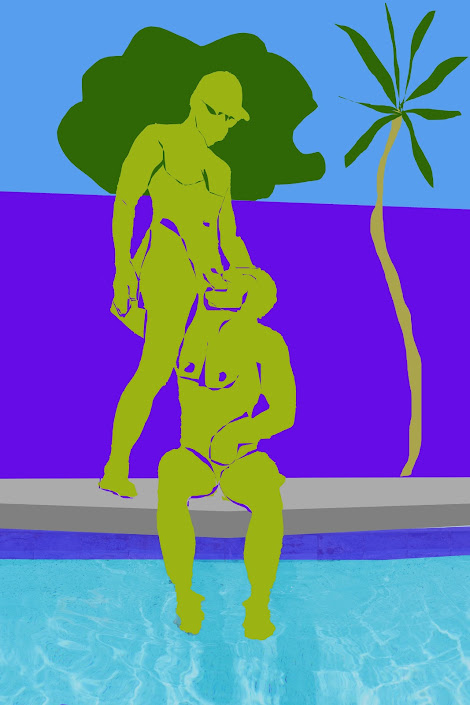Men, past and present, who weren't ashamed be seen naked. You must be at least 18 years of age to visit this blog. Notify me if you hold a copyright on any material used and wish it to be removed.
Followers
Thursday, July 31, 2025
Wednesday, July 30, 2025
Photographers - Part 72
Terry Hastings
Terry Hastings, born in 1965, is a photographer and digital artist living in Palm Springs, California. Earlier, we saw some of his artwork derived from photos that he had taken.
Here's another example. The photo above is called Minotaur ...
which he made into this minimalist painting, also called Minotaur.
But he took many photos that never became paintings. He grouped them into 4 categories corresponding to the 4 elements of ancient philosophy: earth, water, air, and fire. Above, one of the "earth" photos, called Endeavor.
An "earth" photo called High Up.
A "water" photo called Hockney's Swimmer.
A "water" photo called Everlasting Love.
Hastings referred to the "air" element as "wind". Above, a "wind" photo called Magnetism.
A "wind" photo called Innuendo does not show the model naked, but it's rather suggestive.
A "fire" photo called Warm Touch shows two men touching in the firelight ...
as does the "fire" photo called Embrace.
A final category of Hastings' photos is the photocollage, which he makes by digitally joining pieces of dozens of images. The photocollage above is called Goodbye.
This photocollage is called Nude Descending the Stairs ...
which was clearly inspired by the famous 1912 painting Nude Descending a Staircase by Marcel Duchamp, above. In this case the painting came first and the photo afterwards.
But normally Hastings starts with a photo and turns it into a painting. We end with another example. Although many of Hastings' photos and paintings depict naked men, they very rarely show actual sex acts. Plumeria, above, is one of the rare exceptions.
Hastings turned it into the minimalist painting Plumeria, above.
Tuesday, July 29, 2025
Calendars - Part 72
Animal Men 2015
Today's calendar is called Animal Men. I don't know who created it. Here's the calendar cover page.
Most of these calendars don't show frontal views, but January is an exception.
Although the cover page title is in English, all the month names are German, so I presume this is a German calendar.
Each page shows a naked man with a different kind of animal.
The same horse that was on the cover, and a nice rear view of the same man.
All the other photos feature a live animal, but July only uses a shell.
All kinds of animals are featured, like octopi for August. The frontal view is hidden by darkening it ...
but it's actually there, as a little brightening in Photoshop reveals.
A parrot ...
a couple of bearded dragons ...
and the calendar ends with what looks like a Biblical reference to Adam, the snake, and the apple.
Monday, July 28, 2025
Protests - Part 72
Raipur, India 2023
On July 18, 2023, in Raipur, India, youths belonging to Scheduled Caste (SC) and Scheduled Tribe (ST) communities did a naked protest on the first day of the legislative assembly session to protest against reserved SC/ST jobs being stolen by ineligible people using fake caste certificates.
The video shows mostly rear views, but it had a few frontal views. I made a gif of one of them, above.
Police chased the protesters and arrested 29 of them. They were later granted bail. And the protest was a success. Two days later, the government ordered the immediate dismissal of employees who secured their government jobs through fraudulent caste certificates.
Sunday, July 27, 2025
Ivy League Posture Photos - Part 51
Ivy League Posture Photos
Yale started taking nude photos of incoming freshmen in 1919 as part of a program to detect and correct posture problems. The Yale photos have erroneously been associated with William Sheldon, a psychologist at Harvard and author of Nazi-like eugenic theories who used Harvard nude posture photos to illustrate his theory of somatypes. The Yale program predates Sheldon, and, as far as I can tell, the Yale photos were never connected to Sheldon's work.
Here are posture photos of eight more Yale students that I had the opportunity to acquire. For privacy reasons, I redact the names of men who might still be alive. One of these men may still be alive, so his name has been redacted.
This is Yale freshman J. T. on Oct. 9, 1953.
In 1952, Yale installed an apparatus using mirrors to photograph the front, rear, side and top view.
This is Yale freshman Philip R. Lottinville on Oct. 9, 1953.
Note the strange pins stuck to each student's back and chest.
This is Yale freshman Carleton T. Woodring, Jr. on Oct. 16, 1953.
The pins were stuck on at specific points for later posture analysis. Supposedly, by examining the angles formed by connecting the points where the pins touched the body, certain posture problems could be detected.
This is Yale freshman Thomas Garcon Parker on Oct. 21, 1958.
If posture problems were detected, the student had to attend remedial posture sessions, and a second posture photo was taken.
This is Yale freshman Thomas Marsden Osgood on Jan. 31, 1951.
Photos taken before 1952 show only a side view.
This is Yale freshman John Horace Owen on Oct. 1, 1951.
The photography and analysis of the photos was conducted by the staff of Yale's Payne Whitney Gymnasium.
This is Yale freshman Andrew Maute Spieker on Jan. 31, 1951.
Nobody outside the gymnasium staff saw the photos, and the photos were not published for other students to see.
This is Yale freshman Nils Ronald Tongring on Sept. 27, 1951.
The posture photo program was discontinued in the 1960s, and later, most of the photos were burned. However, some of the photos escaped burning, including the photos that I have been showing in this series.
* * *
Note: some of my followers consider these photos an invasion of privacy for the students. To protect the privacy of the students, I redact the names of students who may still be alive. I only publish the names of students who have died. Legally, the right to privacy does not extend beyond death, i.e. it does not extend to spouses and relatives of the deceased person.
I consider these photos to be a historical record of the time. Almost all of the Ivy League posture photos were burned when their existence became widely known. In my opinion, that was akin to book-burning of books that someone claimed were obscene. These photos are not obscene. They should be celebrated, not hidden away.
Saturday, July 26, 2025
Ads - Part 70
NOVA Allir úr
In 2020, the Icelandic telecommunications company NOVA ran a series of ads and commercials featuring full-frontal nudity. Above, an ad on the side of a bus stop.
"Allir úr" means "The everything watch" in Icelandic. The ads were promoting Samsung and Apple smartwatches that claim to do everything that a smartphone can do. But in a play on words, "Allir úr" also means "Take off everything." So the ads are saying that one of these watches is all you need, showing people wearing just a watch and nothing else.
In case the nudity in the previous ads was too subtle, here's another ad. This one says "With Nova's solution, you have everything you need." The model appears to be the guy on the left in the previous ad.
And here's another view of the same guy, for those who appreciate rear views. The small wording at left says "The largest entertainment venue in the world." Well, their ads were certainly entertaining.
Friday, July 25, 2025
Bodybuilders - Part 24
John Farbotnik
Last time, we saw how Melvin Wells became embittered because he lost the Mr. America title in 1950 to John Farbotnik. Many thought that Farbotnik won because he was white and Wells was black. Above, John Farbotnik as Mr. America 1950.
But John Farbotnik (1925-1998) was a remarkable bodybuilder in his own right. He was originally from Philadelphia and won a few bodybuilding titles on the East Coast before moving to California.
In 1946, Farbotnik posed for Al Urban, resulting in the rest of the photos in this post.
Of course, after Farbotnik won Mr. America in 1950, Al Urban promoted that fact for selling the photos.
After moving to California, Farbotnik struggled to find work and took a manual labor job.
According to an article by Gene Mozee in the April 1992 issue of Iron Man magazine, Farbotnik decided to enter the 1950 Mr. America contest 30 days before the contest, even though his weight was down to 170 pounds.
He proceeded to gain an astonishing 27 pounds of muscle to compete at 197 pounds and win the title of Mr. America.
After his competitive career, Farbotnik took up coaching and training. He owned a gym in Glendale, California. Mozee said "Farbotnik was a remarkable bodybuilder and one of the most knowledgeable experts on training that I have ever met." He died in 1998 at age 72.



%20Endeavor.jpg)
%20High%20Up.jpg)
%20Hockney's%20Swimmer.jpg)
%20Everlasting%20Love.jpg)
%20Magnetism.jpg)
%20Innuendo.jpg)
%20Warm%20Touch.jpg)
%20Embrace.jpg)
%20Goodbye.jpg)
%20Nude%20Descending%20the%20Sairs.jpg)




























.jpg)
.jpg)

.jpg)
.jpeg)